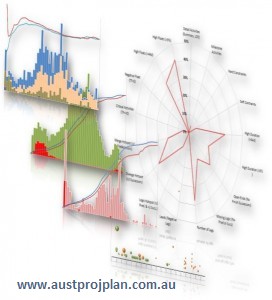Disclaimer
Firstly I’ll preface this article with a big disclaimer – Schedule metrics, and Schedule analytics will only reveal some elements of a Schedule, and even less about what the Schedule represents. They should only form part of an overall Schedule assessment.
The Basics
Disclaimer aside, what are some key metrics that can be used? Lets go back to the basics of Schedules – calendars, activities and relationships. If a Schedule is constructed with sensibly scoped activities and corresponding durations, using the correct calendars, and linked in a logical method, it can be considered to be well constructed, but of course if it doesn’t represent the project execution strategy , the Schedule may be completely meaningless – we’ll keep that for another topic.
The items to be aware of when inspecting a Schedule include:
- Activity Scope, do the activities represent the projects strategy? are durations inconsistent with that required to manage the project (eg high durations), or are there a high number of milestones
- Incorrect, or missing relationships, that can result in high values of floats or fancy negative time application
- Is there a critical path, are there many critical paths? and does the critical path(s) seem sensible for the project the Schedule represent
- Overuse of constraints to hold activities to set dates, rather than letting the Schedule itself derive the dates
Metrics
A sample of key metrics for the above categories that be used are shown below:
Activities
- The ratio of each activity type over the total number of activities (eg, does the Schedule contain a high number of Start Milestones)
- The count of activities by key work breakdown structure elements (eg, does design have very few activities compared to construction)
- The ratio of selected duration distributions over total number of activities (eg, The Schedule has a high number of activities with over 100 days duration)
Relationships
- Ratio of the various relationship types used (eg, are there a high number of Start-to-Finish relationships?)
- Ratio of relationships per activity (eg are activities in a highly strung network)
- Ratio of open ends (eg, are there a high number of activities with no successors)
- The ratio of Lags (eg ratio of relationships using lags, or negative lags)
Float
- Ratio of critical activities (eg, are there a high proportion of activities that are critical)
- Ratio of high floats (eg, is there a high proportion of activities with high float values)
Constraints
- Constraint Types used (eg what is the ratio of activities that have hard constraints placed upon them)
- Constraint Distribution (eg, are activities relying on their constraint date, or are driven by the schedule to other dates)
Services
Australasian Project Planning can provide a Schedule Metric Assessment as a standalone service, or can incorporate when conducting the following:
- Schedule Risk Analyses: as a precursor to determine if the Schedule is suitable to conduct an analysis
- Programme Review: as one component of an overall assessment of a Projects Schedule
References
Whilst still a subjective matter, there are some Schedule Metric references that can assist in an assessment:
- Defense Contract Management Agency (DCMA) 14 point Schedule Assessment
- National Defense Industrial Association (NDIA) Planning and Scheduling Excellence Guide (PASEG)
- US Government Accountability Office (GAO) – Schedule Assessment Guide: Best Practices for Project Schedules -Exposure Draft
Tools
There are many tools available that can analyse Schedules and produce metrics, Australasian Project Planning recommends the use of XER Toolkit to perform many of the above metrics (and many other features) if dealing with Primavera Schedules.


